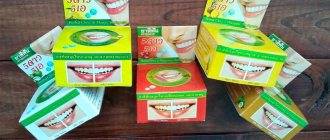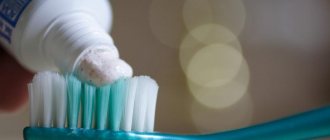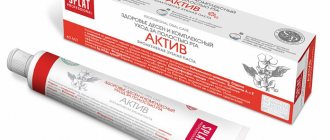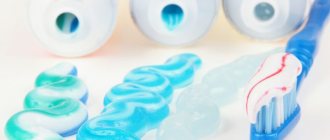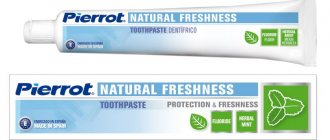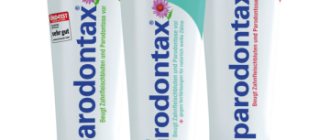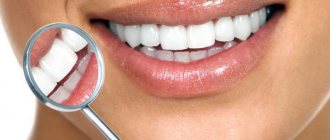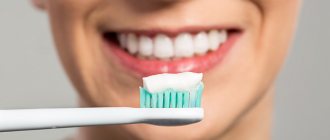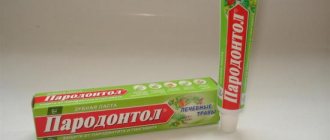Author of the article:
Soldatova Lyudmila Nikolaevna
Candidate of Medical Sciences, Professor of the Department of Clinical Dentistry of the St. Petersburg Medical and Social Institute, Chief Physician of the Alfa-Dent Dental Clinic, St. Petersburg
The appearance of dental plaque is a natural process that cannot be avoided. Coffee, red wine, coloring foods and dishes, smoking, drinking poor-quality water - all this leads to teeth acquiring an unaesthetic dark shade. But is it possible to get rid of this unpleasant manifestation? Of course you can. First, you should have your teeth professionally cleaned by your dentist regularly. And secondly, it is important to use high-quality anti-plaque toothpaste.
What is tartar?
Hardened plaque is called tartar or calculus. This stone is a serious danger to the health of your gums and teeth. As a rule, it forms in those places of the teeth that cannot be reached with a brush, for example, between the teeth, next to the molars.
Dentists consider the following factors to be the main reasons for the formation of tartar:
- Poor oral hygiene. Saliva reactions constantly occur in the mouth; bacteria constantly multiply in the cavity and provoke the appearance of plaque. If you do not remove such plaque with toothpaste and a brush, over time it will begin to build up on the enamel and harden.
- Smoking and frequent consumption of tea and coffee are also common causes of plaque and tartar.
Various diseases of the oral cavity and gastrointestinal tract (GIT) often lead to plaque. The problem is also caused by chewing on one side.
Is there a way out?
As popular wisdom says, almost any problem can be solved. Most often, when people discover darkened enamel, they run to the dentist and ask to urgently eliminate this defect. The whitening procedure undoubtedly gives an excellent, immediately visible result, but it requires quite a lot of money, which is not acceptable for everyone. In addition, this kind of action is very harmful to our teeth, not to mention the fact that the result cannot be called durable.
There is also a less expensive option for solving this problem - disposable whitening trays, which can be found in almost any pharmacy. However, they also cannot boast of the longevity of the effect.
Finally, there are a number of folk methods for eliminating this problem: you can find a lot of information about the benefits of activated carbon, salt or soda for these purposes. However, calling these procedures effective can only be a stretch, and you often have to worry more about safety than about the whiteness of your teeth.
How does plaque appear?
Dental plaque is formed in several stages:
- A soft bacterial plaque begins to settle on the enamel.
- If the oral cavity is not cleaned properly, plaque begins to harden within a few days.
- Then the plaque is mineralized, saturated with phosphorus and calcium, and cleaning teeth from such plaque becomes quite a difficult task.
How to choose toothpaste to fight plaque?
When purchasing anti-plaque toothpaste, you should pay attention to the following parameters of the product:
- RDA level.
The higher the number next to this inscription, the more abrasive particles there are in the toothpaste. If you need to remove hard plaque, you should select pastes with an index of more than 100 units. And those with sensitive enamel should not even try products with an indicator exceeding 70 units. - Fluorine and fluorides
are substances with very ambivalent benefits. Remember, their quantity must be standardized. In large doses, these compounds are toxic and can lead to enamel destruction. A safe amount of fluoride is no more than 0.6%. - Sodium lauryl sulfate (SLS)
often forms foam in toothpaste. Unfortunately, sodium lauryl sulfate is harmful to the body, and you should choose toothpastes that do not contain it. - Triclosan
is an antibiotic that is used to destroy pathogenic flora. However, along with the infection, beneficial bacteria are also killed, which negatively affects the acid balance in the mouth. It is better to buy pastes without this element. - Calcium carbonate
is an abrasive that, in addition to its beneficial effect, neutralizes the effect of fluorides.
How to clean teeth from caries
People don't like going to the dentist, that's a fact. Only this can explain such a widespread prevalence of caries. According to unofficial statistics, about 98% of the world's population suffers from this dental disease. And this despite the fact that with proper daily hygiene and professional cleaning of the oral cavity by a dentist at least once every six months, cariogenic bacteria would have no chance.
The proposed material discusses the basic principles of caries prevention and the algorithm for treating the disease depending on the stage of the pathological process. We will devote a little time to the reasons for the development of pathology, since this is necessary to understand the principles of organizing the preventive process.
Causes of caries
The first question we must ask ourselves is, what is tooth decay? This is a dental disease in which tooth enamel and dentin are destroyed. The order of development of the pathological process is exactly this: first, the carious defect develops in the enamel, and then moves to deeper dentin tissue. With a complicated disease, pathogenic bacteria penetrate even deeper into the soft tissues, and pulpitis develops.
The cause of caries is the development of pathogenic microflora, first on the surface of the enamel, and then in the dental tissues themselves. Bacteria that can cause the development of this disease are usually called cariogenic. This is a large group of microorganisms, many of which are opportunistic and constantly live in the oral cavity.
The cause of caries is the destruction of tooth enamel, and then dentin, by cariogenic microflora!
It is legitimate to talk about predisposing factors that contribute to the development of the disease. The first and most important is poor oral hygiene. Improper or irregular dental care creates the preconditions for the development of pathogenic bacteria. The more soft plaque or tartar on the teeth, the higher the risk of carious destruction.
Another group of predisposing factors is associated with certain conditions of the body. The main manifestation of the first stage of caries development is a decrease in mineralization (reduction in the amount of calcium) of tooth enamel with the formation of first a light and then a brown spot on its surface. Diseases of the endocrine system and other systemic diseases that are accompanied by impaired mineral metabolism contribute to the development of demineralization.
Demineralization can be accelerated by a lack of certain essential substances in the diet. We are not talking about calcium - there is just enough of it in foods. Much more often, doctors diagnose one degree or another of vitamin D deficiency. This vitamin is produced in the skin under the influence of ultraviolet radiation and plays a vital role in mineral metabolism. Vitamin D is low in foods, so if you rarely get exposure to the sun, you need to take it in the form of dietary supplements. It is also beneficial to take vitamin D (in the form of D-3) during the winter months.
Stages of the disease
The disease goes through several stages. Treatment of caries at home (assuming that this is possible, although this is not so) is allowed only at the white/brown spot stage. With superficial, and even more so, medium and deep damage to dental tissues, it is impossible to treat without the help of a specialist. This is a direct road to tooth loss and subsequent expensive dentures!
1. White/brown spot stage.
At this stage there is still no destruction of dental tissues; there is only pronounced demineralization of tooth enamel. The loss of calcium is manifested by the formation of a lightened area on the surface of the dental crown. It can be matte, bright or chalky, but the shade of the stain in any case is different from the color of healthy teeth. Severe pain is not typical for this phase; the patient may only be concerned about increased sensitivity when eating certain foods or cold/hot drinks.
As calcium salts are washed out of the dental tissues, the enamel becomes more and more porous, and food pigments begin to be deposited in it. As a result, the stain becomes brownish in color. This is still the initial stage of the disease, but the tooth is already on the verge of destruction.
2. Stage of superficial carious defect.
If the patient does not seek help at the white spot stage, a carious defect is formed - an area of destroyed enamel. Damaged dental tissue can only be restored using direct restoration, that is, filling. The defect will not heal on its own, and it is no longer possible to cure caries at home. Moreover, treatment with folk remedies can be harmful - a person will have the feeling that he is taking effective measures, although in reality the disease progresses and spreads to deep tissues.
3. Stage of average caries.
Unfortunately, carious destruction often spreads deep into the tooth, because people do not like to go to the dentist and prefer to use simple, albeit absolutely useless, folk remedies. We can talk about average caries when the carious cavity extends beyond the tooth enamel and affects the dentin.
Obviously, if it is impossible to cure the superficial form at home, then with carious damage to dentin, talking about self-treatment is even more pointless. There is no need to hope for a miracle and be treated with folk remedies, including rinsing with herbal tinctures and solutions. The algorithm of actions for the moderate form of the disease will be described in the next section of the article.
4. Stage of deep carious defect.
The development of a deep carious defect is indicated when a thin septum remains between the dentin and the pulp. In fact, the tissue of the crown is destroyed to its entire depth, and only a thin layer of still preserved dentin protects it from the penetration of cariogenic flora into the pulp.
5. Pulpitis
- complication. When cariogenic bacteria penetrate the pulp (soft tissue containing blood vessels and nerves), a complication of caries develops - pulpitis. A person feels severe toothache, which is practically not relieved by conventional analgesics. At this stage, since there is simply no other choice, many turn to a dentist for qualified help, although this should have been done much earlier. Pulpitis therapy is a much more complex, lengthy and expensive process. An uncomplicated form of the disease can be cured faster and cheaper.
How to treat caries
We start from the first stage, when the disease manifests itself in the form of a white or brown spot. How to cure caries at the initial stage of development of the pathological process? The main task is to restore enamel mineralization, that is, to compensate for calcium deficiency. In theory, you can try to do this at home. To do this, you need to brush your teeth with medicated toothpaste with a high content of calcium and fluoride, and also use special dental gels enriched with these compounds.
Unfortunately, self-medication at home does not always give the desired result. This is explained by the fact that even in the best toothpaste the concentration of active elements is lower than in professional products used by a dentist. In addition, an essential condition for success is cleansing the oral cavity from plaque and tartar, and this can only be done in a dental office equipped with an ultrasonic or Air Flow cleaning apparatus.
The correct algorithm looks like this. If an area of enamel lightening appears, you need to make an appointment with a dentist, undergo a teeth cleaning procedure and receive qualified assistance aimed at remineralizing the enamel. At the same time, you can brush your teeth with medicated toothpaste and rinse your mouth with various traditional medicines, for example, solutions of sage, chamomile or calendula.
Without cleaning teeth from plaque, caries treatment will be ineffective!
As an additional measure, it is recommended to take vitamin D, but only in its active form - D-3. It is sold at any pharmacy and is inexpensive. Taking the vitamin in a dosage of 400-800 IU per day will benefit everyone, not just patients with dental diseases.
Treatment of superficial caries
The only effective method is to remove the dental tissue affected by the pathological process, followed by filling the defect. Therefore, the question of how to get rid of caries at home is no longer relevant, unless you have a dental unit and a set of filling materials at home.
The good news is that dental care can be done in one visit to the dentist. The doctor will clean the teeth of plaque and stone, drill out a small area of enamel affected by caries, and place a filling made of photopolymer material. The cost of the procedure is low, since there is no need to depulpate the tooth and seal the root canals, as in the pulpitis stage.
Treatment of medium and deep forms
As in the case of a superficial carious defect, the basis of therapy is the removal of infected and destroyed tissues, followed by restoration of the crown using direct restoration (filling). The key differences relate to the method of preparing the tooth for filling.
With medium and deep lesions, the process spreads to the dentinal tissue. The distance between the carious cavity and the pulp is reduced, which increases the risk of developing pulpitis due to the penetration of microflora into the soft tissue. Therefore, in case of average caries, after drilling out all pathologically changed tissues, an insulating pad is placed on the bottom of the carious cavity. In case of deep damage, the dentist first places a therapeutic pad, and then an insulating one.
Before filling, the carious cavity is treated with powerful antiseptics. The purpose of this manipulation is to kill all microflora, which can lead to the development of relapse. Cariogenic bacteria are resistant to antibiotics in 99% of cases. To destroy them, strong topical agents are used.
After treatment with antiseptic solutions and isolation of the carious cavity from soft tissues, filling is performed. The doctor places a filling made of a light-curing polymer material, restoring the aesthetics and function of the diseased tooth.
If the tooth is more than half destroyed, direct restoration will not be effective enough. The patient may be recommended to reconstruct the coronal part of the tooth with a restorative inlay or through dentures - installing an artificial crown made of ceramic, zirconium or metal ceramics on the tooth stump.
These orthopedic treatment options require preliminary depulpation of the tooth, which significantly increases its final cost. You also need to add the cost of artificial crowns to the price. It is obvious that treating caries in the early stages not only allows you to preserve a living tooth, but also significantly reduces the cost of dental care.
Treatment of pulpitis
It is much more difficult to cure caries complicated by pulpitis. Typically, two, three or even four visits to the dental clinic are required. At the first visit, the doctor drills out the affected dental tissues, removes blood vessels and nerves from the root canals, treats the canals with an antiseptic solution and places a temporary filling.
At the second visit, the temporary filling is removed, the canals are re-treated with an antiseptic and sealed with dental sealant. Sealing the canals is a key condition for successful treatment of pulpitis. If voids remain in the canal, the risk of infection, post-filling pain and relapse increases.
On the third visit, after the dental sealant has completely hardened, a direct restoration of the coronal part of the tooth is performed with a light-curing polymer. Some dentists place a filling on the second visit, but this is the wrong strategy, chosen to save time. It is better to install the seal after the sealant has completely hardened, which takes several days.
conclusions
Treatment of caries should be left to professionals. You should contact the dental clinic at the white spot stage - this will preserve living tissue in full, speed up treatment and reduce its cost. Various self-help options with folk remedies are suitable only as additional measures, as well as the use of medicated toothpaste.
Effective prevention of caries consists of proper daily cleaning of teeth from plaque and food particles using high-quality toothpaste, floss and, if possible, an irrigator. It is also necessary to sanitize the oral cavity at the dentist once every six months. The procedure is combined with a preventive examination, which is very important for the timely and earliest possible diagnosis of dental diseases.
If you still have questions about caries treatment methods, ask them to a qualified medical dentist during your consultation.
Will the paste help with plaque?
According to recent medical research, toothpastes can be effective against plaque and tartar. Regular use of the right product helps prevent the formation of hard plaque. Moreover, high-quality pastes containing a complex of substances to combat plaque destroy dental plaque several times better than single-component products.
An excellent way to combat plaque is ASEPTA SENSITIVE ® Gentle Whitening toothpaste. Enamel whitening occurs through a multi-stage cleansing system, which includes enzymatic components to break down and remove plaque from the surface of the teeth without the use of aggressive acids, abrasives and peroxides that damage the enamel.
The fine abrasives included in this product (RDA 80) remove plaque without leaving microcracks on the enamel. And the combination of “hydroxyapatite and potassium citrate” in the toothpaste prevents the occurrence of increased tooth sensitivity.
An excellent addition in the fight for white teeth will also be the ASEPTA FRESH rinse, a product for daily oral hygiene with a unique combination of xylitol and potassium citrate, which reduces the increased sensitivity of teeth and protects the enamel from the harmful effects of acids and bacteria, and therefore preserves it white and beautiful.
In case of increased tooth sensitivity, ASEPTA SENSITIVE® will perfectly cope with plaque. A paste with a low degree of abrasiveness (RDA 60) allows for oral hygiene without irritating sensitive gums. This product contains a combination of 3 desensitizing components - potassium citrate, thermal mud and hydroxyapatite. The product does not disturb the microflora of the oral cavity and can be used on a regular basis.
Indications for use
ROCS “BLACK EDITION” toothpaste is intended for regular daily use by persons over 18 years of age. The product provides gentle, safe whitening and high-quality therapeutic and preventive care for adult enamel.
This toothpaste can be recommended for thinning enamel and increasing its fragility; with darkening of teeth, a tendency to form staining plaque; in case of risk of dental diseases (gingivitis, caries, periodontitis and others).
ROCS "BLACK EDITION" does not contain parabens, sodium lauryl sulfate, fluorides, triclosan and chlorhexedine. Can be used by people who have visible signs of fluorosis, as well as by people at risk of excess fluoride entering the body (from medications taken, drinking water, etc.).
Is it possible to use anti-plaque pastes in children?
Unfortunately no. Baby teeth are very fragile and delicate. Therefore, no pastes with abrasives can be used in children. Children should choose special children's pastes depending on their age.
It is important for parents to teach their children to prevent plaque formation. You should brush your child’s teeth in the morning and evening, and also allow him to chew carrots and hard apples. Vegetables and fruits will help remove plaque naturally and also provide gum massage. But adult toothpastes can be dangerous for children.
Peculiarities
Despite the fact that the products of this company are often found in pharmacies and stores specializing in cosmetic products, they cannot be called mass-produced. If you study the reviews, Splat toothpaste differs from others at least in that it is developed by truly professionals using the latest technologies and unique recipes. It can safely be called the ideal embodiment of price and quality.
If we omit the positive reviews, Splat toothpaste also differs in the form of presentation - in each box the buyer finds a letter from the general director of the company, which contains a lot of warm words, wishes and suggestions. This charming detail makes the purchase more enjoyable, whether it's a children's toothpaste or a powerful whitening product.
Clinical researches
Repeated clinical studies have proven that regular use of preventive toothpaste ASEPTA SENSITIVE for a month can reduce bleeding gums by 62%, reduce sensitivity of teeth and gums by 48% and reduce inflammation by 66%.
Sources:
- Report on determining/confirming the preventive properties of toothpaste “ASEPTA PLUS” GENTLE WHITENING” Author: doctor-researcher A.A. Leontyev, head Department of Preventive Dentistry, Doctor of Medical Sciences, Professor S.B. Ulitovsky First St. Petersburg State Medical University named after. acad. I.P. Pavlova, Department of Preventive Dentistry
- Clinical studies of antisensitive toothpaste “Asepta Sensitive” (A.A. Leontyev, O.V. Kalinina, S.B. Ulitovsky) A.A. LEONTIEV, dentist O.V. KALININA, dentist S.B. ULITOVSKY, Doctor of Medical Sciences, Prof. Department of Therapeutic Dentistry, St. Petersburg State Medical University named after. acad. I.P. Pavlova
- The role of anti-inflammatory rinse in the treatment of periodontal diseases (L.Yu. Orekhova, A.A. Leontyev, S.B. Ulitovsky) L.Yu. OREKHOVA, Doctor of Medical Sciences, Prof., Head of Department; A.A. LEONTIEV, dentist; S.B. ULITOVSKY, Doctor of Medical Sciences, Prof. Department of Therapeutic Dentistry of St. Petersburg State Medical University named after. acad. I. P. Pavlova
- Report on determining/confirming the preventive properties of toothpaste “ASEPTA PLUS” COFFEE and TOBACCO Author: doctor-researcher A.A. Leontyev, head Department of Preventive Dentistry, Doctor of Medical Sciences, Professor S.B. Ulitovsky. First St. Petersburg State Medical University named after. acad. I.P. Pavlova, Department of Preventive Dentistry
